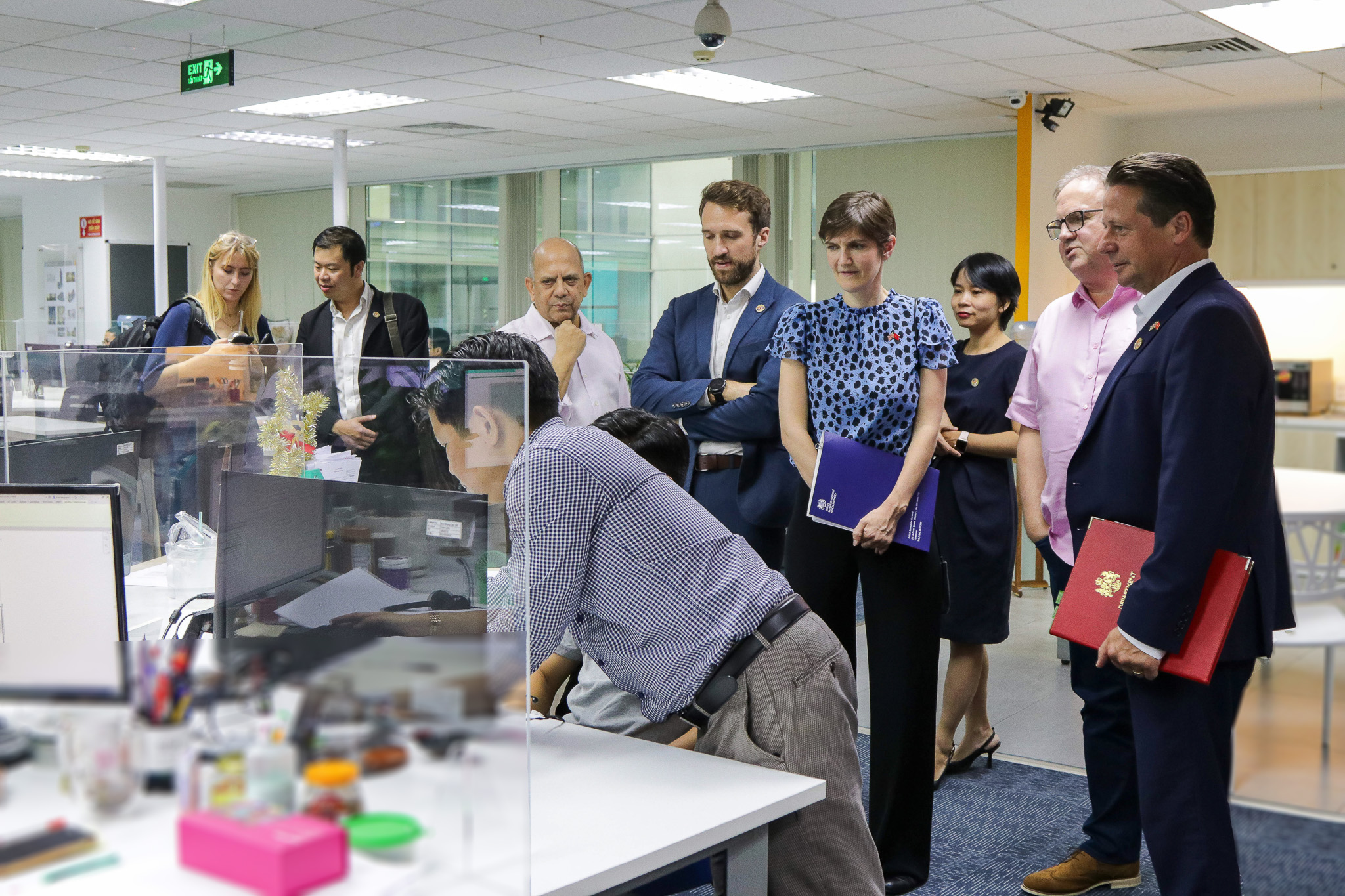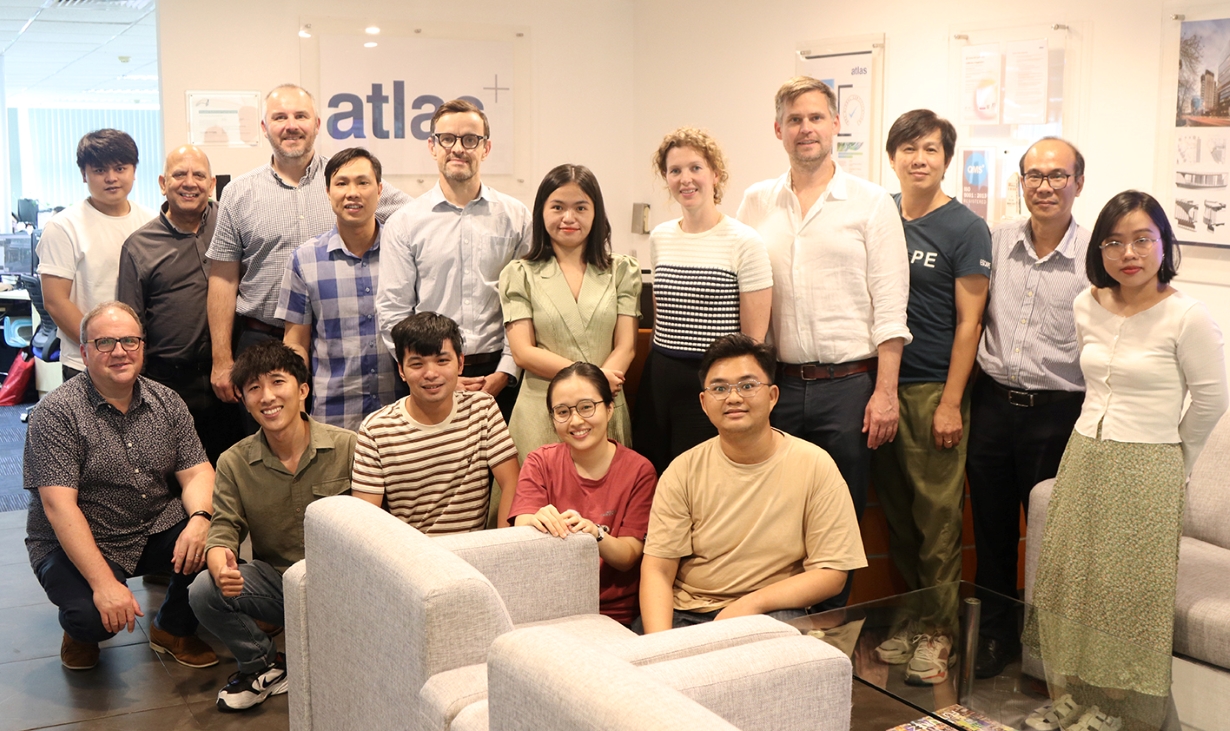Atlas Welcomes Visit From British Government Representatives To
Ho Chi Minh Office

Recently, Atlas had the honor of welcoming Mr. Nigel Huddleston MP - the UK Government Minister for Trade and Ms. Emily Hamblin - Consul General in Ho Chi Minh City for a visit to Atlas’ head office.

Members of the Atlas team led the Minister and Consul General on an office tour, offering a first hand glimpse into Atlas’ services, expertise, and vibrant company culture during the visit. It was an occasion to showcase the breadth of innovative architectural, engineering and infrastructure projects that Atlas is engaged on globally, the cutting-edge technologies applied, and the talented professionals who drive our success.

This visit allowed Atlas to demonstrate to the Minister how we are assisting UK based clients in responding to the requirements of the recent Building Safety Act, discuss the impact of AI on the industry, our training collaboration programmes with local Universities, reinforcing our commitment to supporting our partners in shaping the future of the AEC industry globally.
Related news :
A productive week was had by all during the recent visit to our Ho Chi Minh City office by Make Architects.
There was some great brainstorming and strategising around design documentation support, visualisation, our Python and Dynamo scripts, and where AI is taking the architecture, engineering and construction industry.
We look forward to another eighteen years of collaboration, innovation and supporting Make on exciting projects.
Thank you for taking time out from your busy schedules to visit us.

Atlas has attained Cyber Essentials certification with the UK government-backed scheme led by the National Cyber Security Centre in association with IASME Consortium.
Cyber Essentials is an independently verified self-assessment certification which demonstrates our commitment to a recognised standard of cyber security.
As a provider of BIM modelling, documentation support and project delivery services to the architecture, engineering, and construction industry it is essential that we provide our clients with the assurance that their data is secure.
Click here to learn more about Cyber Essentials certification.
.png)
Atlas is delighted to welcome Khaled Kotb and Maziar Hosseinian to the engineering team. Khaled joins as MEP Associate Director and Maziar as Structural Engineering Associate.
The appointments add to the wide-ranging capability of Atlas’ engineering team who partner with some of the world’s leading consultants and contractors to help improve documentation quality, deliver larger more complex projects and to become more competitive in the marketplace.
Director of Engineering Dr Khoa Tran Kim said, “We are delighted to welcome both Khaled and Maziar to Atlas. As MEP Associate Director, Khaled plays a pivotal role in overseeing the successful execution of large-scale, complex, and multi-disciplinary projects. His technical prowess, combined with exceptional management skills, ensures that our clients receive the highest level of service and project delivery.
Maziar's expertise is in the design and lateral stability analysis of RC high-rise structures utilising advanced analytical methods and the design of structural steel industrial and mining buildings. He is a great addition to the team, overseeing peer reviews, mentoring, and coaching junior engineers in computer modelling and design verifications.”
Prior to joining Atlas Khaled was MEP Senior Manager at Hyundai Engineering and Construction working on the Hanoi Pilot Metro Line PC03 (underground section Hanoi), Vietnam.
Maziar previously held senior/lead structural engineer roles with Australian-based organisations including Taylor Thomson Whitting and SMEC International.
Atlas welcomes both Khaled and Maziar to the company.

About Khaled Kotb
Khaled has over 20 years of professional experience in electrical and mechanical engineering, project management, site supervision, design, value engineering and contract conditions. Since gaining his qualifications from Cairo University he has worked in Egypt, the United Arab Emirates, Hong Kong and Vietnam. His multilingual capabilities in English, Arabic, Tagalog, and French are an advantage to effectively communicate and collaborate with our global clients.
In sharing his vision for the industry and working at Atlas, Khaled said: “Atlas is a well-established organisation with excellent systems. As a team, we combine human values, integrity, and honesty with MEP industry expertise to provide the highest level of performance and professionalism to our clients’ projects.”
With his project experience encompassing all stages of the project lifecycle – concept design, procurement, construction, installation, testing and commissioning – Khaled has successfully delivered electrical and mechanical solutions for rail, high-rise residential and mixed-use, hotels and resorts, healthcare, leisure and industrial projects. He has considerable knowledge of global electrical, electronic and related technologies, standards and codes, including IEC, NEC, BS, NFPA and FIDIC.
khaled.kotb@atlasindustries.com

About Maziar Hosseinian
Maziar is a structural engineer with 14 years’ experience. He gained his Master of Engineering Science in Structural Engineering from the University of New South Wales, Australia.
Upon joining Atlas Maziar said “Coming from an engineering design background in Australia I have been struck by how well informed the Atlas team is of high-level international standards. They are well capable to compete and hold up their own in the global engineering consultancy market and add considerable value to their client’s projects.”
Maziar’s professional experience includes numerous residential, commercial and industrial buildings in Australia and South East Asia. He has extensive knowledge of reinforced concrete, post tensioned and precast concrete and structural steel structures in addition to shallow and deep piled footing systems. Maziar is knowledgeable in the quality control of design and directing the design to value engineering standards and efficient constructability.
maziar.hosseinian@atlasindustries.com
